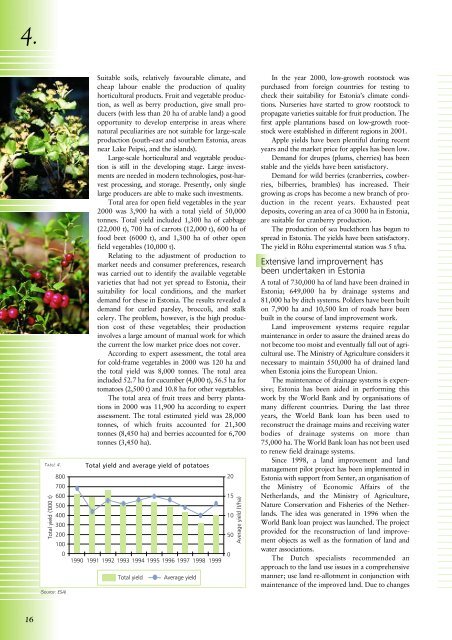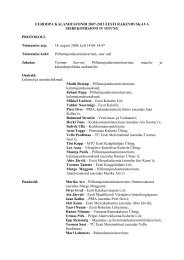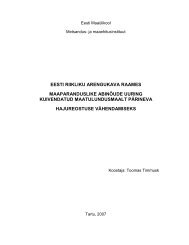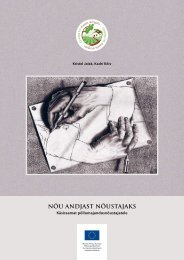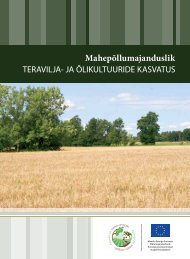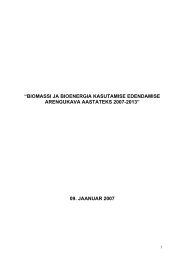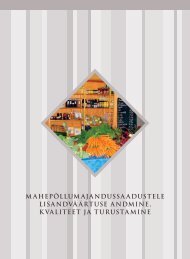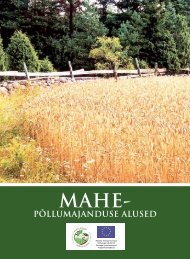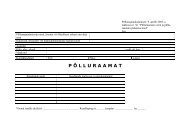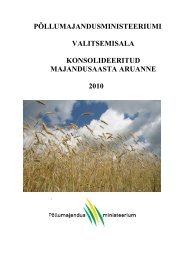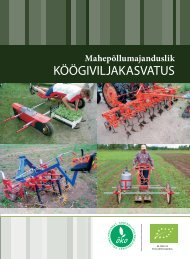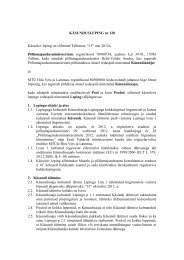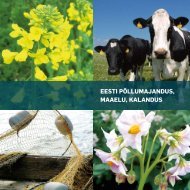estonian agriculture, rural economy and food industry
estonian agriculture, rural economy and food industry
estonian agriculture, rural economy and food industry
Create successful ePaper yourself
Turn your PDF publications into a flip-book with our unique Google optimized e-Paper software.
4.<br />
TABLE 4.<br />
Total yield ('000 t)<br />
800<br />
700<br />
600<br />
500<br />
400<br />
300<br />
200<br />
100<br />
0<br />
(Source: ESA)<br />
Suitable soils, relatively favourable climate, <strong>and</strong><br />
cheap labour enable the production of quality<br />
horticultural products. Fruit <strong>and</strong> vegetable production,<br />
as well as berry production, give small producers<br />
(with less than 20 ha of arable l<strong>and</strong>) a good<br />
opportunity to develop enterprise in areas where<br />
natural peculiarities are not suitable for large-scale<br />
production (south-east <strong>and</strong> southern Estonia, areas<br />
near Lake Peipsi, <strong>and</strong> the isl<strong>and</strong>s).<br />
Large-scale horticultural <strong>and</strong> vegetable production<br />
is still in the developing stage. Large investments<br />
are needed in modern technologies, post-harvest<br />
processing, <strong>and</strong> storage. Presently, only single<br />
large producers are able to make such investments.<br />
Total area for open field vegetables in the year<br />
2000 was 3,900 ha with a total yield of 50,000<br />
tonnes. Total yield included 1,300 ha of cabbage<br />
(22,000 t), 700 ha of carrots (12,000 t), 600 ha of<br />
<strong>food</strong> beet (6000 t), <strong>and</strong> 1,300 ha of other open<br />
field vegetables (10,000 t).<br />
Relating to the adjustment of production to<br />
market needs <strong>and</strong> consumer preferences, research<br />
was carried out to identify the available vegetable<br />
varieties that had not yet spread to Estonia, their<br />
suitability for local conditions, <strong>and</strong> the market<br />
dem<strong>and</strong> for these in Estonia. The results revealed a<br />
dem<strong>and</strong> for curled parsley, broccoli, <strong>and</strong> stalk<br />
celery. The problem, however, is the high production<br />
cost of these vegetables; their production<br />
involves a large amount of manual work for which<br />
the current the low market price does not cover.<br />
According to expert assessment, the total area<br />
for cold-frame vegetables in 2000 was 120 ha <strong>and</strong><br />
the total yield was 8,000 tonnes. The total area<br />
included 52.7 ha for cucumber (4,000 t), 56.5 ha for<br />
tomatoes (2,500 t) <strong>and</strong> 10.8 ha for other vegetables.<br />
The total area of fruit trees <strong>and</strong> berry plantations<br />
in 2000 was 11,900 ha according to expert<br />
assessment. The total estimated yield was 28,000<br />
tonnes, of which fruits accounted for 21,300<br />
tonnes (8,450 ha) <strong>and</strong> berries accounted for 6,700<br />
tonnes (3,450 ha).<br />
Total yield <strong>and</strong> average yield of potatoes<br />
1990 1991 1992 1993 1994 1995 1996 1997 1998 1999<br />
Total yield<br />
Average yield<br />
20<br />
15<br />
10<br />
50<br />
0<br />
Average yield (t/ha)<br />
In the year 2000, low-growth rootstock was<br />
purchased from foreign countries for testing to<br />
check their suitability for Estonia’s climate conditions.<br />
Nurseries have started to grow rootstock to<br />
propagate varieties suitable for fruit production. The<br />
first apple plantations based on low-growth rootstock<br />
were established in different regions in 2001.<br />
Apple yields have been plentiful during recent<br />
years <strong>and</strong> the market price for apples has been low.<br />
Dem<strong>and</strong> for drupes (plums, cherries) has been<br />
stable <strong>and</strong> the yields have been satisfactory.<br />
Dem<strong>and</strong> for wild berries (cranberries, cowberries,<br />
bilberries, brambles) has increased. Their<br />
growing as crops has become a new branch of production<br />
in the recent years. Exhausted peat<br />
deposits, covering an area of ca 3000 ha in Estonia,<br />
are suitable for cranberry production.<br />
The production of sea buckthorn has begun to<br />
spread in Estonia. The yields have been satisfactory.<br />
The yield in Rõhu experimental station was 5 t/ha.<br />
Extensive l<strong>and</strong> improvement has<br />
been undertaken in Estonia<br />
A total of 730,000 ha of l<strong>and</strong> have been drained in<br />
Estonia; 649,000 ha by drainage systems <strong>and</strong><br />
81,000 ha by ditch systems. Polders have been built<br />
on 7,900 ha <strong>and</strong> 10,500 km of roads have been<br />
built in the course of l<strong>and</strong> improvement work.<br />
L<strong>and</strong> improvement systems require regular<br />
maintenance in order to assure the drained areas do<br />
not become too moist <strong>and</strong> eventually fall out of agricultural<br />
use. The Ministry of Agriculture considers it<br />
necessary to maintain 550,000 ha of drained l<strong>and</strong><br />
when Estonia joins the European Union.<br />
The maintenance of drainage systems is expensive;<br />
Estonia has been aided in performing this<br />
work by the World Bank <strong>and</strong> by organisations of<br />
many different countries. During the last three<br />
years, the World Bank loan has been used to<br />
reconstruct the drainage mains <strong>and</strong> receiving water<br />
bodies of drainage systems on more than<br />
75,000 ha. The World Bank loan has not been used<br />
to renew field drainage systems.<br />
Since 1998, a l<strong>and</strong> improvement <strong>and</strong> l<strong>and</strong><br />
management pilot project has been implemented in<br />
Estonia with support from Senter, an organisation of<br />
the Ministry of Economic Affairs of the<br />
Netherl<strong>and</strong>s, <strong>and</strong> the Ministry of Agriculture,<br />
Nature Conservation <strong>and</strong> Fisheries of the Netherl<strong>and</strong>s.<br />
The idea was generated in 1996 when the<br />
World Bank loan project was launched. The project<br />
provided for the reconstruction of l<strong>and</strong> improvement<br />
objects as well as the formation of l<strong>and</strong> <strong>and</strong><br />
water associations.<br />
The Dutch specialists recommended an<br />
approach to the l<strong>and</strong> use issues in a comprehensive<br />
manner; use l<strong>and</strong> re-allotment in conjunction with<br />
maintenance of the improved l<strong>and</strong>. Due to changes<br />
16


